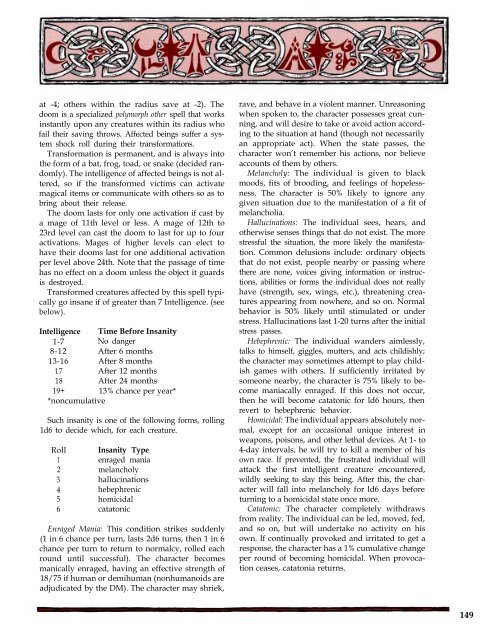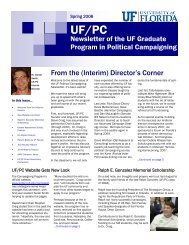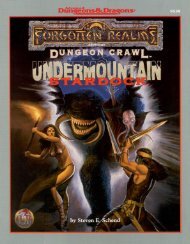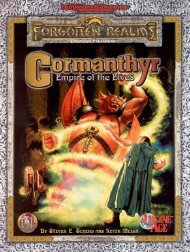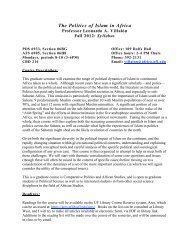Villains' Lorebook.pdf - Department of Political Science
Villains' Lorebook.pdf - Department of Political Science
Villains' Lorebook.pdf - Department of Political Science
You also want an ePaper? Increase the reach of your titles
YUMPU automatically turns print PDFs into web optimized ePapers that Google loves.
at -4; others within the radius save at -2). The<br />
doom is a specialized polymorph other spell that works<br />
instantly upon any creatures within its radius who<br />
fail their saving throws. Affected beings suffer a system<br />
shock roll during their transformations.<br />
Transformation is permanent, and is always into<br />
the form <strong>of</strong> a bat, frog, toad, or snake (decided randomly).<br />
The intelligence <strong>of</strong> affected beings is not altered,<br />
so if the transformed victims can activate<br />
magical items or communicate with others so as to<br />
bring about their release.<br />
The doom lasts for only one activation if cast by<br />
a mage <strong>of</strong> 11th level or less. A mage <strong>of</strong> 12th to<br />
23rd level can cast the doom to last for up to four<br />
activations. Mages <strong>of</strong> higher levels can elect to<br />
have their dooms last for one additional activation<br />
per level above 24th. Note that the passage <strong>of</strong> time<br />
has no effect on a doom unless the object it guards<br />
is destroyed.<br />
Transformed creatures affected by this spell typically<br />
go insane if <strong>of</strong> greater than 7 Intelligence. (see<br />
below).<br />
Intelligence Time Before Insanity<br />
1-7 No danger<br />
8-12 After 6 months<br />
13-16 After 8 months<br />
17 After 12 months<br />
18 After 24 months<br />
19+ 13% chance per year*<br />
*noncumulative<br />
Such insanity is one <strong>of</strong> the following forms, rolling<br />
1d6 to decide which, for each creature.<br />
Roll Insanity Type<br />
1 enraged mania<br />
2 melancholy<br />
3 hallucinations<br />
4 hebephrenic<br />
5 homicidal<br />
6 catatonic<br />
Enraged Mania: This condition strikes suddenly<br />
(1 in 6 chance per turn, lasts 2d6 turns, then 1 in 6<br />
chance per turn to return to normalcy, rolled each<br />
round until successful). The character becomes<br />
manically enraged, having an effective strength <strong>of</strong><br />
18/75 if human or demihuman (nonhumanoids are<br />
adjudicated by the DM). The character may shriek,<br />
rave, and behave in a violent manner. Unreasoning<br />
when spoken to, the character possesses great cunning,<br />
and will desire to take or avoid action according<br />
to the situation at hand (though not necessarily<br />
an appropriate act). When the state passes, the<br />
character won’t remember his actions, nor believe<br />
accounts <strong>of</strong> them by others.<br />
Melancholy: The individual is given to black<br />
moods, fits <strong>of</strong> brooding, and feelings <strong>of</strong> hopelessness.<br />
The character is 50% likely to ignore any<br />
given situation due to the manifestation <strong>of</strong> a fit <strong>of</strong><br />
melancholia.<br />
Hallucinations: The individual sees, hears, and<br />
otherwise senses things that do not exist. The more<br />
stressful the situation, the more likely the manifestation.<br />
Common delusions include: ordinary objects<br />
that do not exist, people nearby or passing where<br />
there are none, voices giving information or instructions,<br />
abilities or forms the individual does not really<br />
have (strength, sex, wings, etc.), threatening creatures<br />
appearing from nowhere, and so on. Normal<br />
behavior is 50% likely until stimulated or under<br />
stress. Hallucinations last 1-20 turns after the initial<br />
stress passes.<br />
Hebephrenic: The individual wanders aimlessly,<br />
talks to himself, giggles, mutters, and acts childishly;<br />
the character may sometimes attempt to play childish<br />
games with others. If sufficiently irritated by<br />
someone nearby, the character is 75% likely to become<br />
maniacally enraged. If this does not occur,<br />
then he will become catatonic for ld6 hours, then<br />
revert to hebephrenic behavior.<br />
Homicidal: The individual appears absolutely normal,<br />
except for an occasional unique interest in<br />
weapons, poisons, and other lethal devices. At 1- to<br />
4-day intervals, he will try to kill a member <strong>of</strong> his<br />
own race. If prevented, the frustrated individual will<br />
attack the first intelligent creature encountered,<br />
wildly seeking to slay this being. After this, the character<br />
will fall into melancholy for ld6 days before<br />
turning to a homicidal state once more.<br />
Catatonic: The character completely withdraws<br />
from reality. The individual can be led, moved, fed,<br />
and so on, but will undertake no activity on his<br />
own. If continually provoked and irritated to get a<br />
response, the character has a 1% cumulative change<br />
per round <strong>of</strong> becoming homicidal. When provocation<br />
ceases, catatonia returns.<br />
149


